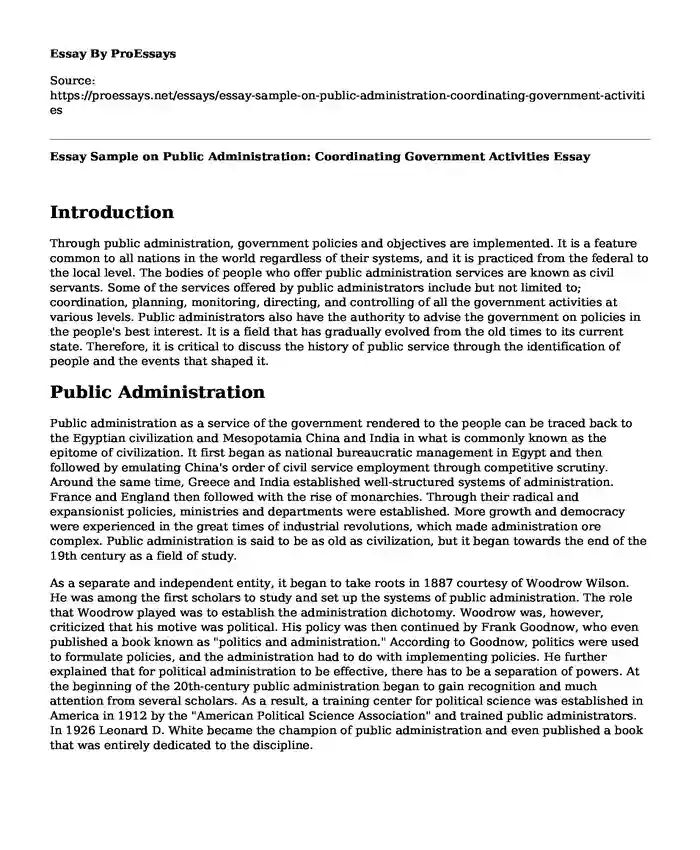Introduction
Through public administration, government policies and objectives are implemented. It is a feature common to all nations in the world regardless of their systems, and it is practiced from the federal to the local level. The bodies of people who offer public administration services are known as civil servants. Some of the services offered by public administrators include but not limited to; coordination, planning, monitoring, directing, and controlling of all the government activities at various levels. Public administrators also have the authority to advise the government on policies in the people's best interest. It is a field that has gradually evolved from the old times to its current state. Therefore, it is critical to discuss the history of public service through the identification of people and the events that shaped it.
Public Administration
Public administration as a service of the government rendered to the people can be traced back to the Egyptian civilization and Mesopotamia China and India in what is commonly known as the epitome of civilization. It first began as national bureaucratic management in Egypt and then followed by emulating China's order of civil service employment through competitive scrutiny. Around the same time, Greece and India established well-structured systems of administration. France and England then followed with the rise of monarchies. Through their radical and expansionist policies, ministries and departments were established. More growth and democracy were experienced in the great times of industrial revolutions, which made administration ore complex. Public administration is said to be as old as civilization, but it began towards the end of the 19th century as a field of study.
As a separate and independent entity, it began to take roots in 1887 courtesy of Woodrow Wilson. He was among the first scholars to study and set up the systems of public administration. The role that Woodrow played was to establish the administration dichotomy. Woodrow was, however, criticized that his motive was political. His policy was then continued by Frank Goodnow, who even published a book known as "politics and administration." According to Goodnow, politics were used to formulate policies, and the administration had to do with implementing policies. He further explained that for political administration to be effective, there has to be a separation of powers. At the beginning of the 20th-century public administration began to gain recognition and much attention from several scholars. As a result, a training center for political science was established in America in 1912 by the "American Political Science Association" and trained public administrators. In 1926 Leonard D. White became the champion of public administration and even published a book that was entirely dedicated to the discipline.
Public Administration Discipline
Between 1927 and 1937, the principles to govern public administration discipline were established, and the principles made it a separate entity formal other bodies of administration. W.F Willoughby wrote down the principles that needed to govern public administration. He explained that public administrators would be experts if they studied the principles and applied them in their work. Another great contributor to public administration's development and evolution is Henri Fayol through his literature “industrial and general management." Through it, the author laid down common principles that leaders can follow to execute their work. Other contributors include James Mooney and Alan Reiley. The epitome was done by Luther Gulick and Lynda Urwicks, who wrote the book “Papers on the science of administration.".
Conclusion
In conclusion, it is important to note that public administration has evolved from ancient times to what every nation has followed today but applied through different systems. It has helped the public benefit from their countries' resources and the implementation of favorable policies done.
References
Frederickson, H. G., Smith, K. B., Larimer, C. W., & Licari, M. J. (2015). The public administration theory primer. Westview Press.
Henry, N. (2015). Public administration and public affairs. Routledge.
Shafritz, J. M., Russell, E. W., & Borick, C. (2015). Introducing public administration. Routledge.
Cite this page
Essay Sample on Public Administration: Coordinating Government Activities. (2023, Nov 16). Retrieved from https://proessays.net/essays/essay-sample-on-public-administration-coordinating-government-activities
If you are the original author of this essay and no longer wish to have it published on the ProEssays website, please click below to request its removal:
- Research Paper on The Red Guards
- Essay Sample on Globalization, Immigration and Current US Administration
- Factors that Caused the Chicago Race Riot of 1919 Essay
- Research Paper on U.S. Loses to Vietnam: Reasons Behind the Historic Defeat
- Essay Sample on The Industrial Revolution: 1789-1914
- Essay Example on Karl Marx: Two Social Classes & Communist Manifesto
- Free Paper on Florida Gov. Rick Scott Signs Marjory Stoneman Douglas HS Public Safety Act into Law







